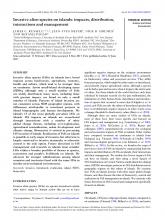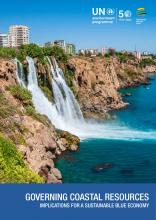Initial recolonization of Funafuti atoll coral reefs devasted by hurricane "Bebe"

Island and Ocean Ecosystems
Available Online
On the 21st of October, 1972, hurricane "Bebe" devas- tated a large part of Funafuti atoll, Ellice Islands. Among the most spectacular geomorphological alterations caused by the hurricane was a storm beach 19 km long, 4 m high and 37 m wide. The amount of coral debris washed up from the offshore coral reefs onto the reef flat was estimated at 2.8 x 10 tons of material (Baines, Beveridge and Maragos, 1974). The oceanside reef communities of the SE and E rim of the atoll had been totally destroyed, and those of the inner reefs of the lagoon side had been heavily damaged. Eight months after the storm a quantitative analysis of the resettlement and recruitment of coral species on 7 reef sections was carried out: the destruction of the biophysiographic zones could be described as increasing from the northern border and also to the W rim of the atoll. Near the centre at Fongafale the lagoon reef flat was covered by thick carpets of the brown alga Dictyota bartaysii, possibly brought about by eutrophication effects. The resettlement of the reef flat by corals began with the recolonization of branching corals as well as regeneration of the very few surviving massive corals: about 80% of the number of new colonies belong to Acropora (mainly A. humilis and A. hyaclnthus), and about 20% to Pocillopora eydouxi, Porltes lutea (?) and some Faviidae. The percentage of the area settled by the massive coral species is, however, greater than that settled by the branching species. Nevertheless, in the long-term, branching corals are expected to have a decisive influence on the future structural and biophysiographic zonation of the reef edge and reef flat, due to their more numerous young colonies, which are evenly scattered over the reef area, and due to their rapid growth rate. Consequently, an Acropora humilis - hyacinthus-community or an Acropora - Pocillopora eydouxi-assemblage can be predicted as the future biophysiographic zone.




